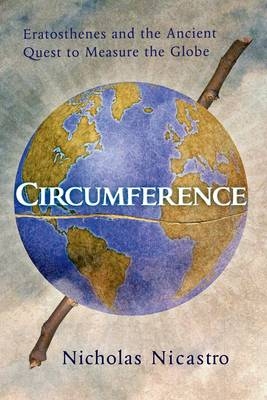
Circumference
Seiten
2015
Saint Martin's Griffin,U.S. (Verlag)
978-1-250-06844-6 (ISBN)
Saint Martin's Griffin,U.S. (Verlag)
978-1-250-06844-6 (ISBN)
- Titel ist leider vergriffen;
keine Neuauflage - Artikel merken
In one of history's greatest experiments, a brilliant Greek, Eratosthenes of Cyrene calculated the distance around the earth to a few percent of the actual size. In an inside glance at the philosophy and practicalities of this discovery, Nicholas Nicastro looks at a deceptively simple but stunning feat made by using only simple tools.
In one of history's greatest experiments, a brilliant Greek, Eratosthenes of Cyrene calculated the distance around the earth to a few percent of the actual size. In an inside glance at the philosophy and practicalities of this discovery, Nicholas Nicastro looks at a deceptively simple but stunning feat made by using only simple tools - a stick, a piece of string, and a shadow. But how was he able to measure the land a time when distance was a matter of a shrug and a ballpark figure of time spent on donkey-back? How could he be confident in underlying assumptions: that the earth was round and the sun was far away its rays struck parallel lines? Was it luck or pure scientific genius? In the exciting narrative history, Nicastro brings readers on a trip into a long-vanished world that prefigured modernity where despite his reputation, validity of method, and position as head of the greatest research institution of the time, Eratosthenes was simply right too soon about earth's dimensions. His results were debated for centuries until he was ultimately vindicated almost 2000 years later during the great voyages of exploration. Luck? Apparently not.
In one of history's greatest experiments, a brilliant Greek, Eratosthenes of Cyrene calculated the distance around the earth to a few percent of the actual size. In an inside glance at the philosophy and practicalities of this discovery, Nicholas Nicastro looks at a deceptively simple but stunning feat made by using only simple tools - a stick, a piece of string, and a shadow. But how was he able to measure the land a time when distance was a matter of a shrug and a ballpark figure of time spent on donkey-back? How could he be confident in underlying assumptions: that the earth was round and the sun was far away its rays struck parallel lines? Was it luck or pure scientific genius? In the exciting narrative history, Nicastro brings readers on a trip into a long-vanished world that prefigured modernity where despite his reputation, validity of method, and position as head of the greatest research institution of the time, Eratosthenes was simply right too soon about earth's dimensions. His results were debated for centuries until he was ultimately vindicated almost 2000 years later during the great voyages of exploration. Luck? Apparently not.
NICHOLAS NICASTRO PhD has taught history, anthropology, and psychology at Cornell University and Hobart-William Smith Colleges. He has written five novels as well as short fiction, travel and science articles for The New York Times, The New York Observer, Film Comment, and The International Herald Tribune, Archaeology, and more. He now lives in northern California
| Verlagsort | New York |
|---|---|
| Sprache | englisch |
| Maße | 140 x 210 mm |
| Themenwelt | Geschichte ► Allgemeine Geschichte ► Vor- und Frühgeschichte |
| Geschichte ► Allgemeine Geschichte ► Altertum / Antike | |
| Mathematik / Informatik ► Mathematik ► Geschichte der Mathematik | |
| Naturwissenschaften ► Geowissenschaften ► Geografie / Kartografie | |
| ISBN-10 | 1-250-06844-4 / 1250068444 |
| ISBN-13 | 978-1-250-06844-6 / 9781250068446 |
| Zustand | Neuware |
| Haben Sie eine Frage zum Produkt? |
Mehr entdecken
aus dem Bereich
aus dem Bereich
auf den Spuren der frühen Zivilisationen
Buch | Hardcover (2023)
C.H.Beck (Verlag)
CHF 27,95
Konzepte – Methoden – Theorien
Buch | Softcover (2024)
UTB (Verlag)
CHF 55,85
Was Pompeji über uns erzählt
Buch | Hardcover (2023)
Propyläen (Verlag)
CHF 44,75


